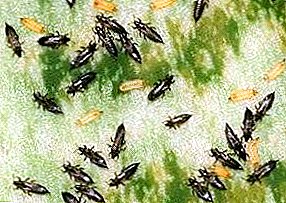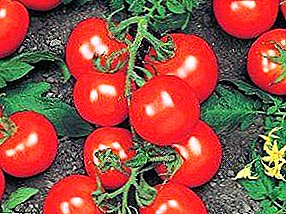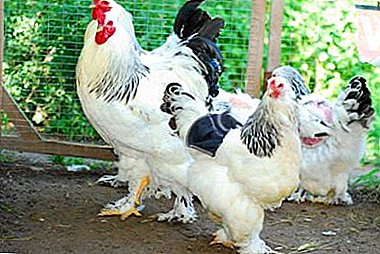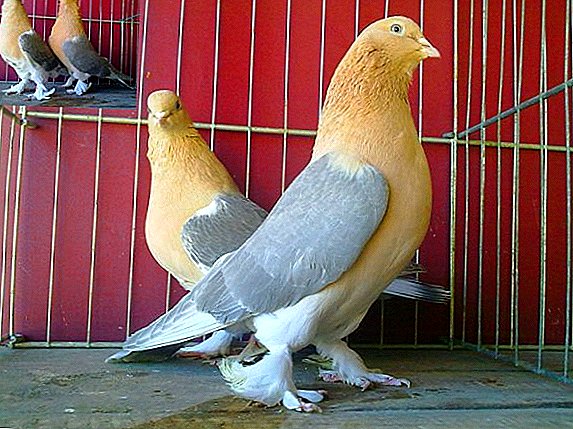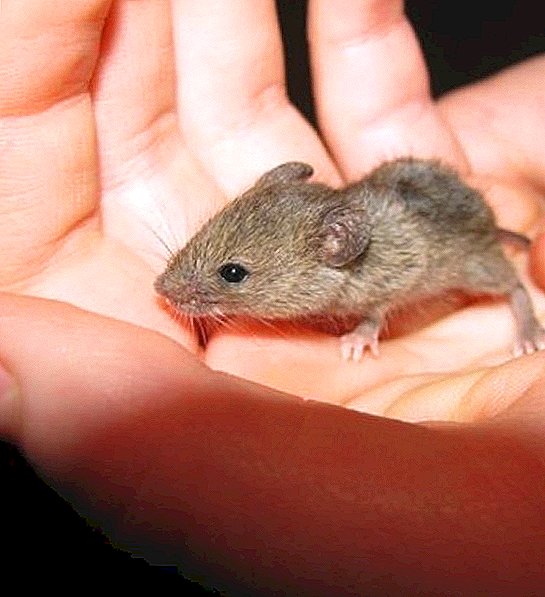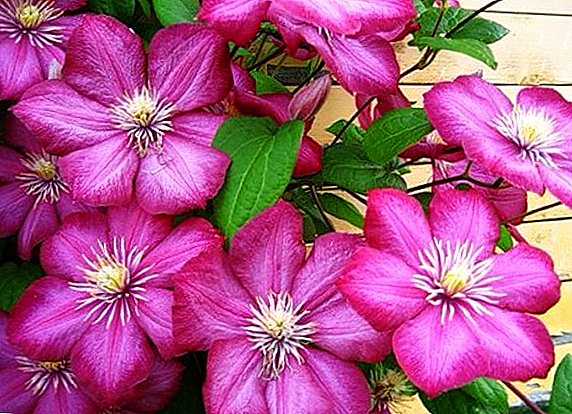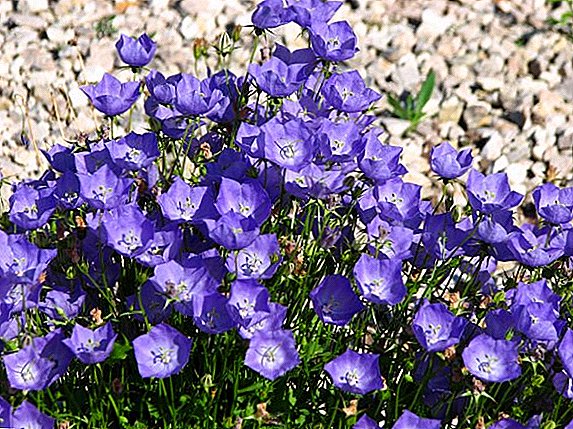 Nature has endowed bell Carpathian extraordinary tenderness and inimitable grace, which landscape designers use to create fabulously beautiful compositions (most often, the flower is used in hills). Planted in groups, these flowers form dense bushes with a scattering of large, cup-shaped flowers. To tell all about the flowers of bells, you need a whole treatise, so we turn your attention only to the most important points in their cultivation.
Nature has endowed bell Carpathian extraordinary tenderness and inimitable grace, which landscape designers use to create fabulously beautiful compositions (most often, the flower is used in hills). Planted in groups, these flowers form dense bushes with a scattering of large, cup-shaped flowers. To tell all about the flowers of bells, you need a whole treatise, so we turn your attention only to the most important points in their cultivation.
Site selection and soil for planting
 Carpathian bell is not whimsical by nature, so its landing and further care can be carried out both in sunny places and in partial shade. The best soil for this plant is fertile, with good drainage, neutral or slightly acidic. In heavy, poorly drained soils, where frequent stagnation of water occurs, the bell quickly dies from excessive waterlogging. If you plant a flower in heavy loamy soil, then when digging add sand and deoxidized peat. Excessively friable sandy soils should be mixed with humus or with sod land. By observing these requirements, you will provide your plants with good conditions for wintering.
Carpathian bell is not whimsical by nature, so its landing and further care can be carried out both in sunny places and in partial shade. The best soil for this plant is fertile, with good drainage, neutral or slightly acidic. In heavy, poorly drained soils, where frequent stagnation of water occurs, the bell quickly dies from excessive waterlogging. If you plant a flower in heavy loamy soil, then when digging add sand and deoxidized peat. Excessively friable sandy soils should be mixed with humus or with sod land. By observing these requirements, you will provide your plants with good conditions for wintering.
Growing a Carpathian bluebell from seed
Sowing seeds, prepared for bells, is the most common method of growing a plant. The weight of a thousand seeds is very small and amounts to only a quarter of a gram. Under good conditions, for germination, 4000 grains will be produced from one gram of seeds.
Did you know? In ancient times, our ancestors believed that with a bell, you can attract a loved one. The girl had to tear the plant at dawn and attach it to the window shutter. Soon the one who loved had to come to visit.
Sowing seeds for seedlings
 The seeds of this plant are very capricious, therefore, in order for them to germinate well, a certain thermal hardening is required. Preparation of planting material and planting should begin in February. From this point on, the seeds should be kept for one month at a temperature of + 20 ° C under diffused light, wetting them evenly. Also, they must always receive fresh air. These requirements to the microclimate are very important for the successful growth of seeds. Those shoots that appeared prematurely, earlier than planned, need to be transplanted into a separate container.
The seeds of this plant are very capricious, therefore, in order for them to germinate well, a certain thermal hardening is required. Preparation of planting material and planting should begin in February. From this point on, the seeds should be kept for one month at a temperature of + 20 ° C under diffused light, wetting them evenly. Also, they must always receive fresh air. These requirements to the microclimate are very important for the successful growth of seeds. Those shoots that appeared prematurely, earlier than planned, need to be transplanted into a separate container.
Further heating of the planted material should be changed by temperature quenching with a range from -4 ° C to + 4 ° C. This stage should last a month and a half. At the same time, it is very important for the seedlings to be affected by natural environmental factors, but it is advisable to keep the temperature in the box under control while it is very low outside. The most successful seeds grow under a layer of lush snow, which protects them from freezing, and melt water on sunny days provides the necessary moisture. Quenching lasts as long as the average daily temperature is at a level higher than the upper limit of the specified range. As soon as the first shoots appear, the container with the earthen substrate should be transferred to a room in which the temperature is in the range from + 10 ° C to + 15 ° C.  This method of hardening seeds is very time consuming, but at the same time very effective. There is another breeding method for bluebells, in which the seeds are not sown directly into the soil, but are treated in a mixture of wet sand in a plastic bag. At the first stage, they are heated according to the type of the first method, but at the second stage - the hardening is transferred to the refrigerator for the same period as in the first embodiment. Then, the seed material is placed in the boxes with the prepared soil mixture (without burial) and sent to conditions with a temperature regime of + 10 ° C ... + 15 ° C. In order not to blur the seeds, they are not watered, but sprayed with a spray gun. The soil substrate can also be moistened with microcapillaries through a pan of water.
This method of hardening seeds is very time consuming, but at the same time very effective. There is another breeding method for bluebells, in which the seeds are not sown directly into the soil, but are treated in a mixture of wet sand in a plastic bag. At the first stage, they are heated according to the type of the first method, but at the second stage - the hardening is transferred to the refrigerator for the same period as in the first embodiment. Then, the seed material is placed in the boxes with the prepared soil mixture (without burial) and sent to conditions with a temperature regime of + 10 ° C ... + 15 ° C. In order not to blur the seeds, they are not watered, but sprayed with a spray gun. The soil substrate can also be moistened with microcapillaries through a pan of water.
Important! The substrate, before sowing seeds into it, must be well moistened and saturated with moisture.
After sowing, soil moisture and seed lighting should be controlled. Optimal conditions for growth occur after 10-25 days from the moment of planting. Shoots one way or another will be very thick, hence the pick should be started as soon as the first leaves appear. To greatly harm the seedlings, you can replant them in groups of 4 plants in one pot for seedlings or multi-cell plates. Only ascended bells need to moderately moisturize and often give fresh air to breathe. The first fertilizer is applied 14 days after the pick.
This is the most appropriate time, as the Carpathian bells will move away from stress and fully restore their root system. Carpathian bell can already be planted on a permanent "place of residence" in the open ground, when his seedlings reached one month old. It must be well lighted and ventilated, as well as not prone to strong waterlogging. In the worst case, the bells will gradually be oppressed and more often exposed to various kinds of diseases.
Sowing seeds in open ground
 The Carpathian bell is well adapted to various conditions, so its seed planting can be carried out immediately in open ground. This event should be held in the fall in mid-October or in spring, in May. It is necessary to plant the bell seeds in a mixture of sand, sod land and weathered peat. The soil should be light, loose and well ventilated. Organic fertilizer seeds do not need. Since the planting material is very small, it needs to be spread directly on the soil surface and a little sprinkled with sand. Spring shoots germinate in two weeks, and autumn in 10-14 days after thawing the ground.
The Carpathian bell is well adapted to various conditions, so its seed planting can be carried out immediately in open ground. This event should be held in the fall in mid-October or in spring, in May. It is necessary to plant the bell seeds in a mixture of sand, sod land and weathered peat. The soil should be light, loose and well ventilated. Organic fertilizer seeds do not need. Since the planting material is very small, it needs to be spread directly on the soil surface and a little sprinkled with sand. Spring shoots germinate in two weeks, and autumn in 10-14 days after thawing the ground.
Important! Carpathian bell refers to the species, the seeds of which sprout better after hardening, so it will be more logical to plant them right before the snow falls.
When three full leaves appear on the plant, the seedlings can be dived according to the 10x10 cm scheme.
How to care for bells on the site?
Unpretentious in the care of the bell Carpathian does not impose special requirements on the environment, so its cultivation will not become a burden to you.
How to conduct watering?
It is necessary to carry out watering only in the period of a long heat. Then you have to spend up to 10 liters of water for each adult plant. After watering, the soil in the root zone must be weeded and loosened to allow free air circulation.
Fertilization
Fodder feeding should be done twice per season. The first is in early spring, when it is still snowing, by introducing nitrogenous fertilizers. The second - in the period of budding, the bushes will perfectly respond to fertilizing with complex fertilizers based on minerals.
Pruning inflorescences
 Transplantation of young flowers to a permanent "place of residence" is carried out at the beginning of summer. The following year, when the bell is blooming, be ready for a quick pruning of flowering inflorescences. This is necessary in order to prevent spontaneous self-seeding. Otherwise, a lot of interfering with each other, randomly growing flowers may appear nearby. Fruits-boxes need to be collected before darkening and disclosure. If you want to plant bells, then just put them in the soil from August to September or next May. Regular cutting of dried buds of the Carpathian bluebell will prolong its flowering periods. And if at the end of it shortly pruned all flower stalks, in a month the plant will bloom again.
Transplantation of young flowers to a permanent "place of residence" is carried out at the beginning of summer. The following year, when the bell is blooming, be ready for a quick pruning of flowering inflorescences. This is necessary in order to prevent spontaneous self-seeding. Otherwise, a lot of interfering with each other, randomly growing flowers may appear nearby. Fruits-boxes need to be collected before darkening and disclosure. If you want to plant bells, then just put them in the soil from August to September or next May. Regular cutting of dried buds of the Carpathian bluebell will prolong its flowering periods. And if at the end of it shortly pruned all flower stalks, in a month the plant will bloom again.
Soil mulching
Since the Carpathian bell does not tolerate moisture stagnation, the soil for its cultivation must be loose. However, during periods of extreme heat, in order to avoid rapid evaporation and preserve the necessary moisture, it must be mulched on the contrary. Those plants that grow on stony hills, do not need this event. The bells do not tolerate neighborhoods with weeds, so you should promptly and very carefully eliminate weeds from flower beds.
Did you know? According to old beliefs, the bell brings love to young people, peace to old people and generally makes people happy.
Carpathian bell in landscape design
 Carpathian bell is so attractive flower that you should pay due attention to its description. It reaches a height of 30 cm. The leaves are heart-shaped, small, collected in the socket and increasing closer to the roots. Due to this arrangement, a neat spherical bush with a diameter of 30 cm is formed. Single flowers in the shape of funnels of white, purple and blue shades in large numbers cover the whole bush of the plant. The Carpathian bell is perfectly adjacent to bright daisies, sweet lobelias, fragrant alissum and lush obrietta.
Carpathian bell is so attractive flower that you should pay due attention to its description. It reaches a height of 30 cm. The leaves are heart-shaped, small, collected in the socket and increasing closer to the roots. Due to this arrangement, a neat spherical bush with a diameter of 30 cm is formed. Single flowers in the shape of funnels of white, purple and blue shades in large numbers cover the whole bush of the plant. The Carpathian bell is perfectly adjacent to bright daisies, sweet lobelias, fragrant alissum and lush obrietta.
Very attractive composition of colorful plants. Among the alpine hills, the Carpathian bell is successfully combined in the design of the garden with saxifrage, periwinkle, young and stonecrop. When making rock aria, plant bells on the background of carnations, grass, styloid phlox, fescue and iberis. Recently in landscape design trends in the placement of flowering plants in flowerpots are popular. Gentle Carpathian bells are planted with beds framing the paths, as well as mixed flower beds with mostly low-growing flowers.
Disease and pest resistance
Diseases and pests for the Carpathian bell are mostly not terrible, so the plant is rarely affected by them. However, with many years of growing flowers in one place in the soil, there is an accumulation of pathogenic microorganisms - fusarium, sclerotinia and botrytis. They can destroy the plant. To prevent this, twice a season (in the spring and autumn periods), process the flowers with a solution of "Fundazol" in a concentration of 0.2%.  During periods of high humidity on the bells there is a slobbering penny, which is displayed garlic extract. The leaves and shoots of the flower are subject to invasions of slugs and snails. You can drive pests with Thunder and Meta. Also, the leaves of bluebells are often covered with rust, which copper-containing preparations help to fight. In order to prevent her from hitting the plant, it is necessary to conduct regular preventive spring and autumn tillage with Gumi or Fitosporin preparations.
During periods of high humidity on the bells there is a slobbering penny, which is displayed garlic extract. The leaves and shoots of the flower are subject to invasions of slugs and snails. You can drive pests with Thunder and Meta. Also, the leaves of bluebells are often covered with rust, which copper-containing preparations help to fight. In order to prevent her from hitting the plant, it is necessary to conduct regular preventive spring and autumn tillage with Gumi or Fitosporin preparations.
Did you know? It is said that this flower served as a prototype of the bell, therefore its Latin name is “campanula”, which is derived from the word “campana” - translated as “bell”. In Italy, the so-called belltower - Campanilla.
Other ways of propagation of the bell Carpathian
Halong with seed propagation of the bellflower, there are also vegetative methods: dividing the bush and grafting. Their use allows you to increase the number of plants in the summer and autumn. Also, during vegetative propagation, the possibility of over-pollination and splitting of signs is excluded, therefore obtaining identical planting material and transmission of all varietal characteristics is guaranteed.
Cuttings
 Carpathian bell for grafting is driven out at a temperature of + 10 ° C. Cuttings should be cut to the size of three centimeters with one or two buds. Favorable periods for this are spring months. During this time, you can get a lot of planting material. The cuttings root very well and the root system is fully formed after three weeks. Plant cuttings need to multi-cell plate of three pieces each. The substrate is prepared as follows: take in equal proportions of earth, sand and humus, and then mix them.
Carpathian bell for grafting is driven out at a temperature of + 10 ° C. Cuttings should be cut to the size of three centimeters with one or two buds. Favorable periods for this are spring months. During this time, you can get a lot of planting material. The cuttings root very well and the root system is fully formed after three weeks. Plant cuttings need to multi-cell plate of three pieces each. The substrate is prepared as follows: take in equal proportions of earth, sand and humus, and then mix them.
Plant the cuttings and cover with a layer of sand a couple of centimeters. The sand has a good absorption capacity, therefore, it retains moisture well, remaining loose and ventilated. This has a positive effect on young roots. The most suitable conditions can be created with the help of a fine fogging installation under plastic wrap. The use of vegetative propagation methods significantly accelerates the flowering of the bell.
Dividing bush
Carpathian bell is very convenient in care, as it multiplies in three ways. The last method we consider is the division of the bush. You can take only those bells that have reached the age of three. The procedure is carried out at the beginning of May or at the end of August, that is, at the extreme stages of the growing season. Uterine plants need to dig, cut off all the shoots and cut the rhizome into pieces, which are planted in shallow holes. If it becomes necessary to divide the bush into very small parts, then they will have to be grown in containers. Here it is already necessary to introduce additional fertilizing with liquid fertilizers.


